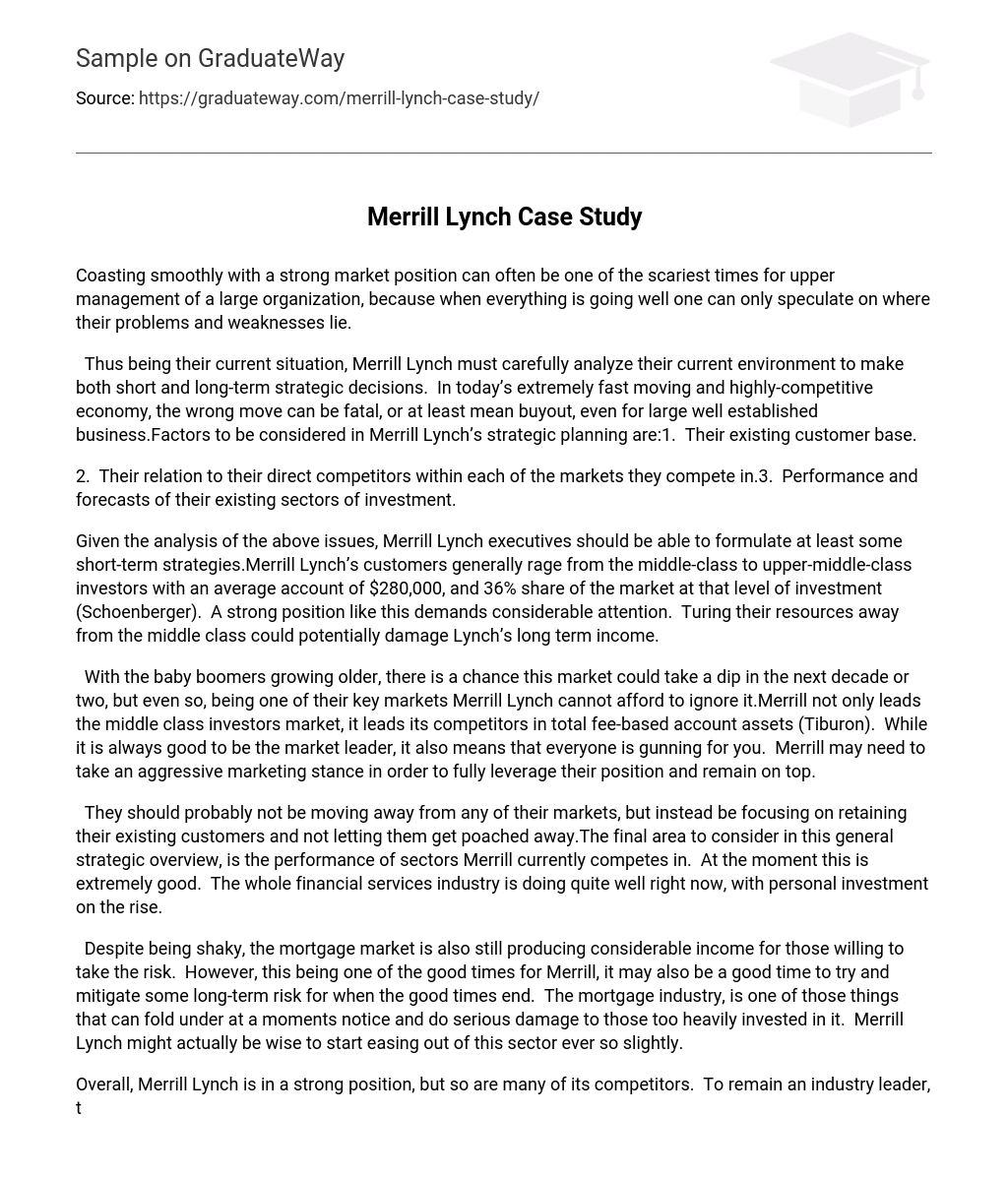Coasting smoothly with a strong market position can often be one of the scariest times for upper management of a large organization, because when everything is going well one can only speculate on where their problems and weaknesses lie.
Thus being their current situation, Merrill Lynch must carefully analyze their current environment to make both short and long-term strategic decisions. In today’s extremely fast moving and highly-competitive economy, the wrong move can be fatal, or at least mean buyout, even for large well established business.Factors to be considered in Merrill Lynch’s strategic planning are:1. Their existing customer base.
2. Their relation to their direct competitors within each of the markets they compete in.3. Performance and forecasts of their existing sectors of investment.
Given the analysis of the above issues, Merrill Lynch executives should be able to formulate at least some short-term strategies.Merrill Lynch’s customers generally rage from the middle-class to upper-middle-class investors with an average account of $280,000, and 36% share of the market at that level of investment (Schoenberger). A strong position like this demands considerable attention. Turing their resources away from the middle class could potentially damage Lynch’s long term income.
With the baby boomers growing older, there is a chance this market could take a dip in the next decade or two, but even so, being one of their key markets Merrill Lynch cannot afford to ignore it.Merrill not only leads the middle class investors market, it leads its competitors in total fee-based account assets (Tiburon). While it is always good to be the market leader, it also means that everyone is gunning for you. Merrill may need to take an aggressive marketing stance in order to fully leverage their position and remain on top.
They should probably not be moving away from any of their markets, but instead be focusing on retaining their existing customers and not letting them get poached away.The final area to consider in this general strategic overview, is the performance of sectors Merrill currently competes in. At the moment this is extremely good. The whole financial services industry is doing quite well right now, with personal investment on the rise.
Despite being shaky, the mortgage market is also still producing considerable income for those willing to take the risk. However, this being one of the good times for Merrill, it may also be a good time to try and mitigate some long-term risk for when the good times end. The mortgage industry, is one of those things that can fold under at a moments notice and do serious damage to those too heavily invested in it. Merrill Lynch might actually be wise to start easing out of this sector ever so slightly.
Overall, Merrill Lynch is in a strong position, but so are many of its competitors. To remain an industry leader, they will have to keep the focus on their existing customers and the level of service they provide. Furthermore, they do need to remove themselves from the riskier end of the mortgage market to protect themselves from any losses that might scare investors away from them. Merrill Lynch may not enjoy a reputation as the wisest investors, but their customers are happy with them and appreciate the service they provide.
Only by continuing this same level of service, and preventing embarrassing losses, can Merrill Lynch hold on to their strong market position through the rest of the decade. Work Cited“MER – Merrill Lynch & Co., Inc. Income Statement.
” Forbes.com. Forbes.com LLC.
2007. <http://finapps.forbes.com/finapps/jsp/finance/compinfo/IncomeStatement.
jsp?tkr=MER&period=qtr>. Schoenberger, Chana R. “Trading Places.” Forbes.
com. Forbes.com LLC. 2007.
<http://www.forbes.com/free_forbes/2006/1211/174.html>.
Tiburon. Turnkey Asset Management Programs. Tiburon Strategic Advisors. 2005.





